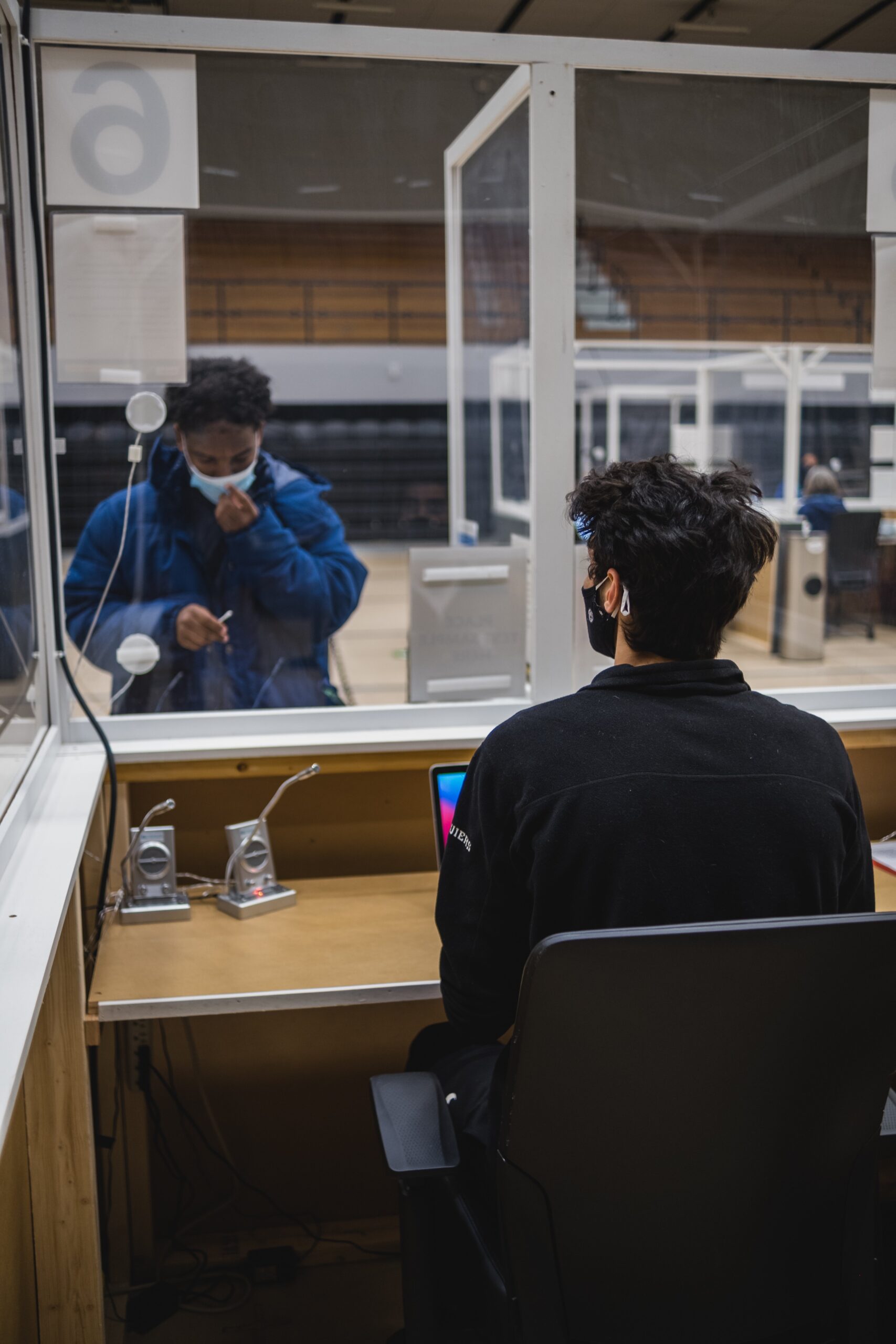Reflecting on COVID-19 two months into the semester
April 8, 2021
 Cheng Xing
Cheng XingTwo months into a spring semester like no other and with over 1,000 students on campus Bowdoin has managed to keep its positive COVID-19 case numbers relatively low. Despite a recent uptick in cases, it has also managed to stay in the least restrictive campus status level—”yellow”—since leaving “Hibearnation” and three days of “orange” in mid-February.
Already, the College has administered a total of 22,020 student and 16,771 employee COVID-19 tests this semester. Of those, there have been nine total positive student cases and 16 positive employee cases. There are currently nine active cases on campus: two students and seven employees, with 13 students in quarantine.
“I’ve been really proud of Bowdoin students,” COVID-19 Resource Coordinator Mike Ranen said in a Zoom interview with the Orient. “I think they’ve been committed to forming a bubble and trying to stay within that bubble. It’s not perfect, but I think … they understand how challenging last March was and [don’t want] to do that again.”
Last semester, when about 600 students—primarily first-year and transfer students, as well as students completing honors projects and those with home environments not conducive to learning—were on campus, there were a total of five student cases and eight employee cases. Of those, two students and seven employees tested positive in November, reflecting the national spike in COVID-19 in the late fall and early winter.
“The fall and the spring are really different for a number of reasons,” Ranen said. “[In the fall, we had a] majority of first-year students on campus trying to figure out ways to navigate college and to develop friendships. I think they leaned heavily on our ResLife staff which is great … we had a few cases upon arrival, and then we were relatively quiet [until] we had a few cases at the end. So, kind of mirroring what was happening nationally.”
Ranen attributes this semester’s success to both student attitudes towards campus restrictions and administrators setting clear expectations from the beginning.
“We give upperclass students more freedom and more responsibility,” said Ranen. “There’s more student leadership this semester, so there’s been more student-driven programming, which helps. [But] I think the reason this spring has been so successful is that we had a slow ramp up. I think clamping down hard and setting expectations from the beginning helped give us a time of relatively few COVID-19 cases.”
 Cheng Xing
Cheng XingIncreases in case numbers at Bowdoin, Bates and Colby this semester reflect another statewide increase. Bates and Colby, unlike Bowdoin, invited all students back to campus for both the fall and spring semesters. Although case numbers are not exactly comparable for this reason, both Bates and Colby have seen substantial outbreaks since the beginning of the spring semester.
Colby, with 23 positive cases in isolation and 94 students in quarantine, is currently in status level “yellow,” although, unlike Bowdoin’s status level bearing the same name, this is Colby’s second-least restrictive tier after “green.” Overall, the campus has seen 107 positive cases since reopening in January, many from an early outbreak in February. Of those, 88 have been students and 19 have been employees—a contrast to Bowdoin, which has seen more employee cases than student cases overall.
Bates initially saw low case numbers but has recently had an outbreak believed to be linked to three separate student gatherings in late March. Currently, there are 79 active student cases, 101 students in quarantine and four active employee cases. As a result, “in-room restriction,” in which students are required to remain in their rooms except to pick up meals or attend their testing appointments, has been extended through the weekend.
“Unmasked social gatherings are the largest contributors to COVID[-19] transmission on campuses across the country. It is critically important that you respect the in-room restrictions and refrain from participating in un-masked or un-distanced social gatherings of any size,” reads an April 6 email sent to the Bates student body from Bates Vice President for Campus Life Joshua Macintosh and obtained by the Orient. “Your cooperation in this regard is the single most effective thing you can do to help us bring current case counts down so that we can lift restrictions and resume in-person classes and other activities.”
Bates, like Colby, has seen substantially more student cases than employee cases, with 108 cumulative student cases this semester and eight cumulative employee cases.
“[What we’ve learned from our peer schools is that] we should limit travel and we should limit parties,” said Ranen. “It’s hard…. [we’re working with] college students. And it’s the travel. When you leave the bubble, [COVID-19 is] everywhere.”

Comments
Before submitting a comment, please review our comment policy. Some key points from the policy: